We are proud to be certified organic by Oregon Tilth. Here are some of the practices we use to bring you delicious, organic vegetables each season.
Building Soil Fertility
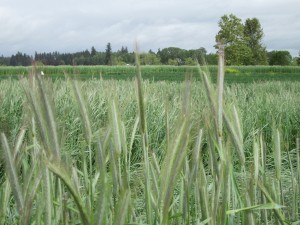 A healthy soil will produce healthy crop plants that have optimum vigor and are less susceptible to pests. Here at SIO we employ a myriad of methods to protect and enhance the productivity of the soil including using cover crops, reducing tillage, avoiding traffic on wet soils, and whenever possible maintaining soil cover.
A healthy soil will produce healthy crop plants that have optimum vigor and are less susceptible to pests. Here at SIO we employ a myriad of methods to protect and enhance the productivity of the soil including using cover crops, reducing tillage, avoiding traffic on wet soils, and whenever possible maintaining soil cover.
Regular use of cover crops can increase soil stability, soil tilth, and diversity of soil microbial life. Depending on where we are in the season we use one or a mixture 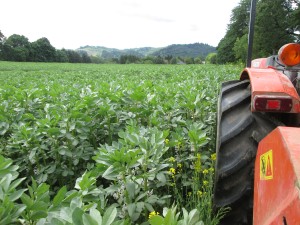 of several different covers such as Sudan, rye, oats, vetch, Favas, clover or buckwheat. Several of these cover crops actually fix atmospheric nitrogen as they grow. When these cover crops are turned back into the soil, the nitrogen will become available to future crops. This added nitrogen helps to cut down on the amount of nitrogen that we have to import from off the farm.Cover crops also add organic matter to the soil. Organic matter feeds the soilecosystem and improves soil structure – increasing the soil’s capacity to hold water and air. When a cover crop is growing in the field, it helps to prevent soil erosion
of several different covers such as Sudan, rye, oats, vetch, Favas, clover or buckwheat. Several of these cover crops actually fix atmospheric nitrogen as they grow. When these cover crops are turned back into the soil, the nitrogen will become available to future crops. This added nitrogen helps to cut down on the amount of nitrogen that we have to import from off the farm.Cover crops also add organic matter to the soil. Organic matter feeds the soilecosystem and improves soil structure – increasing the soil’s capacity to hold water and air. When a cover crop is growing in the field, it helps to prevent soil erosion 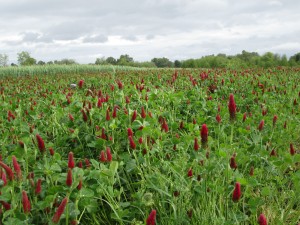 thus holding soil and nutrients in place. Cover crops also out compete weeds which can mean less tilling.
thus holding soil and nutrients in place. Cover crops also out compete weeds which can mean less tilling.
Cover crops are a crop that we grow to feed the soil but most of the crops that we grow leave the farm to feed you thus it is necessary for us to amend the soil with minerals and nutrients sourced from off the farm. Each season, we test our soil and assess its nutrient needs so to not add too much or too little to the soil. The amendments we apply are always from organic sources such as kelp meal, crustacean meal, feather meal, blood meal, sulphate of potash, fish bone meal, oyster shell flour, lime, soft rock phosphate, gypsum, and/or green sand.
Managing Pests & Disease
O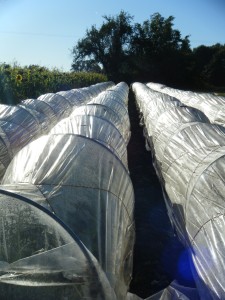 ur primary strategy to control pests and disease on the farm is to grow healthy plants in healthy soils. Plants that get the nutrients, water, and air that they need are less likely to succumb to pests and disease. Our highly diverse crop mix allows us to rely on crop rotations to suppress weeds, pathogens and insect pests. In addition to crop diversity, insectary flower plantings and a native plant hedgerow create habitat for a diversity of insect life. This habitat attracts insects we call “beneficials” as they prey on some of our insect pests. Some pests are still persistent enough on the farm that we need to protect our crops. To do this,
ur primary strategy to control pests and disease on the farm is to grow healthy plants in healthy soils. Plants that get the nutrients, water, and air that they need are less likely to succumb to pests and disease. Our highly diverse crop mix allows us to rely on crop rotations to suppress weeds, pathogens and insect pests. In addition to crop diversity, insectary flower plantings and a native plant hedgerow create habitat for a diversity of insect life. This habitat attracts insects we call “beneficials” as they prey on some of our insect pests. Some pests are still persistent enough on the farm that we need to protect our crops. To do this, 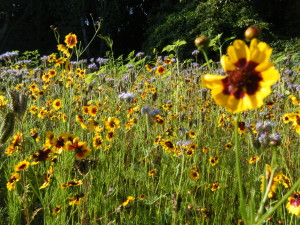 we use a floating row cover that drapes over the crop providing a physical barrier between the crop and the pest. We employ best cultural practices such as trellising or drip irrigation to ensure each of our 40 crops is grown to minimize pest and disease pressures. Finally, when a few pests make there mark, we rely on our customers, to know that the very occasional blemish can easily be cut off – leaving a great tasting crop to enjoy.
we use a floating row cover that drapes over the crop providing a physical barrier between the crop and the pest. We employ best cultural practices such as trellising or drip irrigation to ensure each of our 40 crops is grown to minimize pest and disease pressures. Finally, when a few pests make there mark, we rely on our customers, to know that the very occasional blemish can easily be cut off – leaving a great tasting crop to enjoy.
Managing H2O
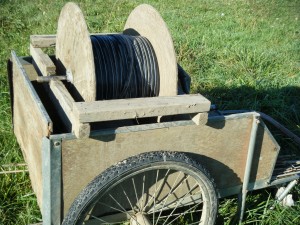 Because water is such a precious resource, we use drip irrigation where ever possible. Drip irrigation is more efficient at delivering water directly to the plants roots and looses less water to evaporation than other methods of irrigating. When we do need to water with overhead sprinklers, we try to do it overnight to minimize the amount of water lost to evaporation.
Because water is such a precious resource, we use drip irrigation where ever possible. Drip irrigation is more efficient at delivering water directly to the plants roots and looses less water to evaporation than other methods of irrigating. When we do need to water with overhead sprinklers, we try to do it overnight to minimize the amount of water lost to evaporation.
Weed Management
Our approach to weed management employs a combination of strategies to keep our fields as weed free as possible and minimize the time we spend weeding either by hand or with our tractors. Our crop rotation plan takes weed pressure into account as does our irrigation plan. Whenever possible, drip irrigation is used to limit the amount of soil surface that is being watered, therefore germinating as few weed seeds as possible. Many crops are started in our propagation house so that they can be planted when they are a few weeks old, giving them a jump start on germinating weeds. When weed seeds do germinate, thermal and mechanical tools are used to set the weeds back. Inevitably we also spend a great deal of time hoeing and pulling weeds by hand.
Recycling on the Farm
Materials that cannot be re-used on the farm are recycled. We are also proud to offer our CSA members the option to recycle their kitchen food scraps through our farm composting program. The compost we generate from this goes into our potting mix which we use in the greenhouse.
Exploring Alternative Fuels
We continue to explore viable alternatives to our dependence on fossil fuels. At this time we use biodiesel to run the tractors on the farm.
